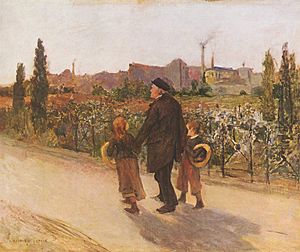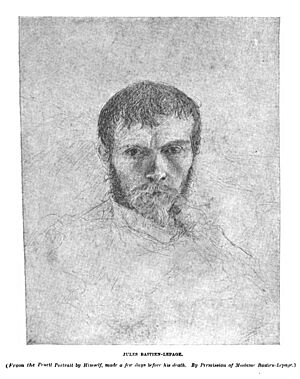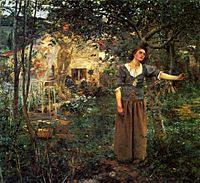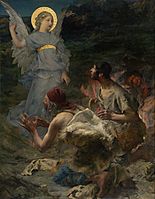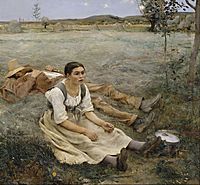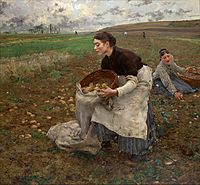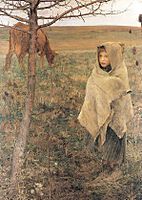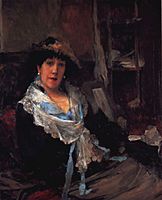Jules Bastien-Lepage facts for kids
Quick facts for kids
Jules Bastien-Lepage
|
|
|---|---|

Self-Portrait
|
|
| Born | 1 November 1848 Damvillers, Meuse, France
|
| Died | 10 December 1884 (aged 36) Paris, France
|
| Education | École des beaux-arts |
| Known for | Painting |
| Movement | naturalism |
| Signature | |
Jules Bastien-Lepage (born November 1, 1848 – died December 10, 1884) was a French painter. He is known for helping start a style of art called Naturalism. This style focused on showing things exactly as they looked in real life. It grew out of an earlier art movement called Realism.
His most famous painting is a portrait of Joan of Arc. It looks like a landscape painting and is now at the Metropolitan Museum in New York City.
Contents
Life and Artworks
Jules Bastien-Lepage was born in a small village called Damvillers in France. He spent his childhood there. His father grew grapes in a vineyard to support the family. His grandfather also lived nearby and had a garden with fruit trees. Jules loved to draw from a young age. His parents helped him by buying art prints for him to copy.
Learning to Paint
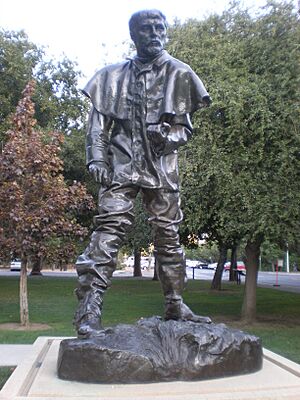
Jules Bastien-Lepage's first art teacher was his own father. He later had formal training in a town called Verdun. In 1867, he moved to Paris because he loved art so much. He joined the École des Beaux-arts, which is a famous art school. There, he studied with a teacher named Cabanel.
Jules was very good at drawing and even won first place for it. But he often preferred to work on his own, not always attending classes. Still, he completed three years at the school. During the Franco-Prussian war in 1870, Jules fought and was hurt. After the war, he went back home to his village to paint and get better. In 1873, he painted his grandfather in the garden. This painting helped him become known at the Paris Salon, a big art show.
Early Paintings and Success
Jules showed his paintings at the Salons in 1870 and 1872, but they didn't get much attention. However, in 1874, his painting Portrait of my Grandfather became very popular. It even won a medal. He also showed Song of Spring, which was a study of country life. It showed a peasant girl sitting on a hill.
His success continued in 1875 with First Communion. This painting of a little girl was very detailed. In 1875, he came in second place in a competition called the Prix de Rome. He entered with his painting Angels appearing to the Shepherds. He tried again in 1876 with Priam at the Feet of Achilles, but he didn't win. After this, he decided to focus more on painting country life.
In 1877, he sent a portrait of "Lady L." and My Parents to the Salon. In 1878, he showed Portrait of M. Theuriet and Haymaking (Les Foins). This last painting, which is now in the Musée d'Orsay, was highly praised. It made him one of the first important painters in the Naturalist style.
Becoming Famous for Naturalism
After the success of Haymaking, Jules Bastien-Lepage was seen as a leader of the new Naturalist art style in France. By 1883, one art critic said that "The whole world paints so much today like M. Bastien-Lepage that M. Bastien-Lepage seems to paint like the whole world." This fame brought him important requests for paintings.
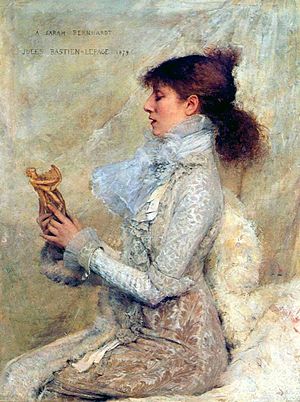
His Portrait of Mlle Sarah Bernhardt (1879) was painted with bright colors. It won him a special award called the Legion of Honour. In 1879, he was asked to paint the Prince of Wales. In 1880, he showed a small portrait of M. Andrieux and Joan of Arc listening to the Voices. This famous painting is now in the Metropolitan Museum of Art.
Other works include The Beggar (1881) and Le Père Jacques (1882). His painting Love in a Village (1885) showed some influence from another artist, Gustave Courbet. His last finished painting was The Forge (1884).
His Final Years and Legacy
Between 1880 and 1883, Jules traveled in Italy. He had been sick for a long time and tried to get better in Algiers, but it didn't work. He died in Paris in 1884. He was planning to paint new pictures of country life. His friend, Prince Bojidar Karageorgevitch, was with him when he passed away. The Prince later wrote:
At last he was unable to work anymore; and he died on the 10th of December, 1884, breathing his last in my arms. At his grave's head his mother and brother planted an apple-tree.
In 1885, more than 200 of his paintings were shown at the Ecole des Beaux-Arts. In 1889, some of his most famous works were displayed at the Paris Exposition Universelle, a big world fair.
Other important works by Jules include a portrait of Mme J. Drouet (1883) and a painting of Léon Gambetta on his death-bed. He also painted some landscapes, like The Vintage (1880) and The Thames at London (1882). A painting called The Little Chimney-Sweep was never finished. Today, there is a museum dedicated to him in Montmédy. A statue of Bastien-Lepage, made by the famous sculptor Rodin, stands in his hometown of Damvillers.
Friendship with Marie Bashkirtseff
Jules Bastien-Lepage was good friends with Marie Bashkirtseff, a painter from Ukraine. She was inspired by his love for painting nature. She once wrote that Bastien-Lepage was like a king of the fields in his paintings. Her most famous work in the Naturalist style is A Meeting. This painting was shown at the Paris Salon in 1884 and was very popular. Sadly, Marie also died from a long illness in the same year as her friend Jules.
Honors and Awards
- 1883: He was made a Knight in the Order of Leopold in Belgium.
Paintings
-
Joan of Arc (1879; Metropolitan Museum of Art)
-
The Annunciation to the Shepherds (1875; National Gallery of Victoria, Melbourne)
-
Haymaking (Les Foins), 1877, Musée d'Orsay
-
October, 1878, National Gallery of Victoria
-
Marie Samary of the Odéon Theater, c. 1881, Cleveland Museum of Art
-
Pas Mèche (Nothing Doing), 1882, Scottish National Gallery
-
L'Amour au Village, 1882, Pushkin Museum
-
Going to School, 1882, Aberdeen Art Gallery
See also
 In Spanish: Jules Bastien-Lepage para niños
In Spanish: Jules Bastien-Lepage para niños


